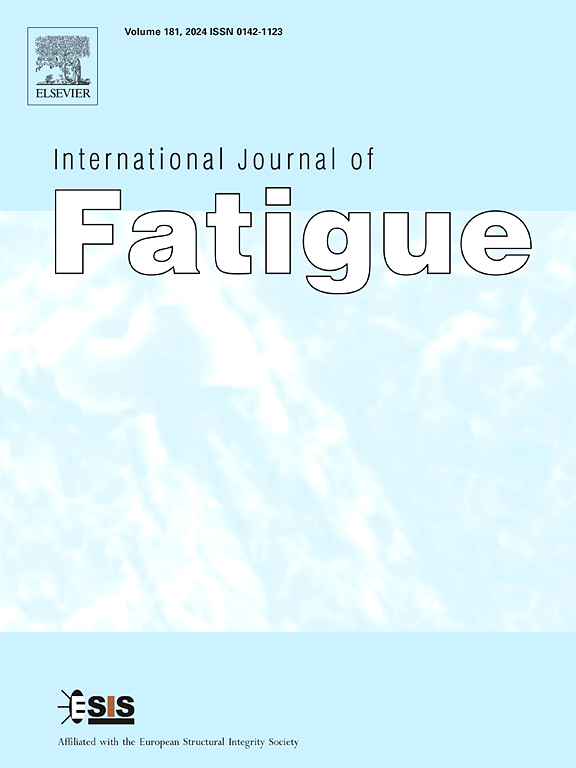The effect of surface gradient nanostructure and compressive residual stress on fretting fatigue of A100 ultra-high strength steel by ultrasonic surface rolling process
IF 6.8
2区 材料科学
Q1 ENGINEERING, MECHANICAL
引用次数: 0
Abstract
The critical challenge in enhancing the fretting fatigue performance of A100 ultra-high strength steel (A100 steel) involved reconciling the conflicting attributes of strength and toughness. In our study, the ultrasonic surface rolling process (USRP) was harnessed to induce gradient nanostructures and a compressive residual stress field on the surface of A100 steel, with the goal of strengthening its wear and fatigue resistance. Through meticulous optimization of USRP parameters over 30 passes, a gradient nanostructure with a substantial depth of approximately 400 μm was successfully formed, while minimizing the martensite lath width on the surface to a mere 44.5 nm. The nanocrystalline mechanism of USRP treatment of A100 steel was the interaction of dislocation proliferation and nailing of nanoscale carbides to form high density low angle grain boundaries and smaller martensitic laths. The introduction of these gradient nanostructures resulted in a notable increase in the depth of the hardened layer and the compressive residual stress field, doubling the original state. Additionally, the fretting fatigue threshold was found to be enhanced by 14.3 %. A factor separation approach revealed that the combined influence of the gradient nanostructure and compressive stress field considerably improved resistance to fretting wear and extended fatigue life. This synergy effectively curbed the nucleation and growth of fretting fatigue cracks, with the compressive residual stress playing a pivotal role in bolstering fretting fatigue resilience.
研究了表面梯度纳米结构和残余压应力对超声表面轧制A100超高强度钢微动疲劳的影响
提高A100超高强度钢(A100钢)微动疲劳性能的关键挑战是协调强度和韧性的冲突属性。在本研究中,利用超声表面轧制工艺(USRP)在A100钢表面诱导梯度纳米结构和压缩残余应力场,以增强其耐磨性和抗疲劳性。通过对USRP参数进行30次优化,成功形成了深度约为400 μm的梯度纳米结构,同时将表面马氏体板条宽度降至44.5 nm。USRP处理A100钢的纳米晶机制是位错扩散与纳米碳化物钉入相互作用,形成高密度低角度晶界和较小的马氏体板条。这些梯度纳米结构的引入导致硬化层深度和压缩残余应力场的显著增加,是原始状态的两倍。此外,微动疲劳阈值提高了14.3%。因子分离分析表明,梯度纳米结构和压应力场的共同作用显著提高了材料的抗微动磨损性能,延长了疲劳寿命。这种协同作用有效地抑制了微动疲劳裂纹的形核和扩展,残余压应力在增强微动疲劳弹性方面起着关键作用。
本文章由计算机程序翻译,如有差异,请以英文原文为准。
求助全文
约1分钟内获得全文
求助全文
来源期刊

International Journal of Fatigue
工程技术-材料科学:综合
CiteScore
10.70
自引率
21.70%
发文量
619
审稿时长
58 days
期刊介绍:
Typical subjects discussed in International Journal of Fatigue address:
Novel fatigue testing and characterization methods (new kinds of fatigue tests, critical evaluation of existing methods, in situ measurement of fatigue degradation, non-contact field measurements)
Multiaxial fatigue and complex loading effects of materials and structures, exploring state-of-the-art concepts in degradation under cyclic loading
Fatigue in the very high cycle regime, including failure mode transitions from surface to subsurface, effects of surface treatment, processing, and loading conditions
Modeling (including degradation processes and related driving forces, multiscale/multi-resolution methods, computational hierarchical and concurrent methods for coupled component and material responses, novel methods for notch root analysis, fracture mechanics, damage mechanics, crack growth kinetics, life prediction and durability, and prediction of stochastic fatigue behavior reflecting microstructure and service conditions)
Models for early stages of fatigue crack formation and growth that explicitly consider microstructure and relevant materials science aspects
Understanding the influence or manufacturing and processing route on fatigue degradation, and embedding this understanding in more predictive schemes for mitigation and design against fatigue
Prognosis and damage state awareness (including sensors, monitoring, methodology, interactive control, accelerated methods, data interpretation)
Applications of technologies associated with fatigue and their implications for structural integrity and reliability. This includes issues related to design, operation and maintenance, i.e., life cycle engineering
Smart materials and structures that can sense and mitigate fatigue degradation
Fatigue of devices and structures at small scales, including effects of process route and surfaces/interfaces.
 求助内容:
求助内容: 应助结果提醒方式:
应助结果提醒方式:


